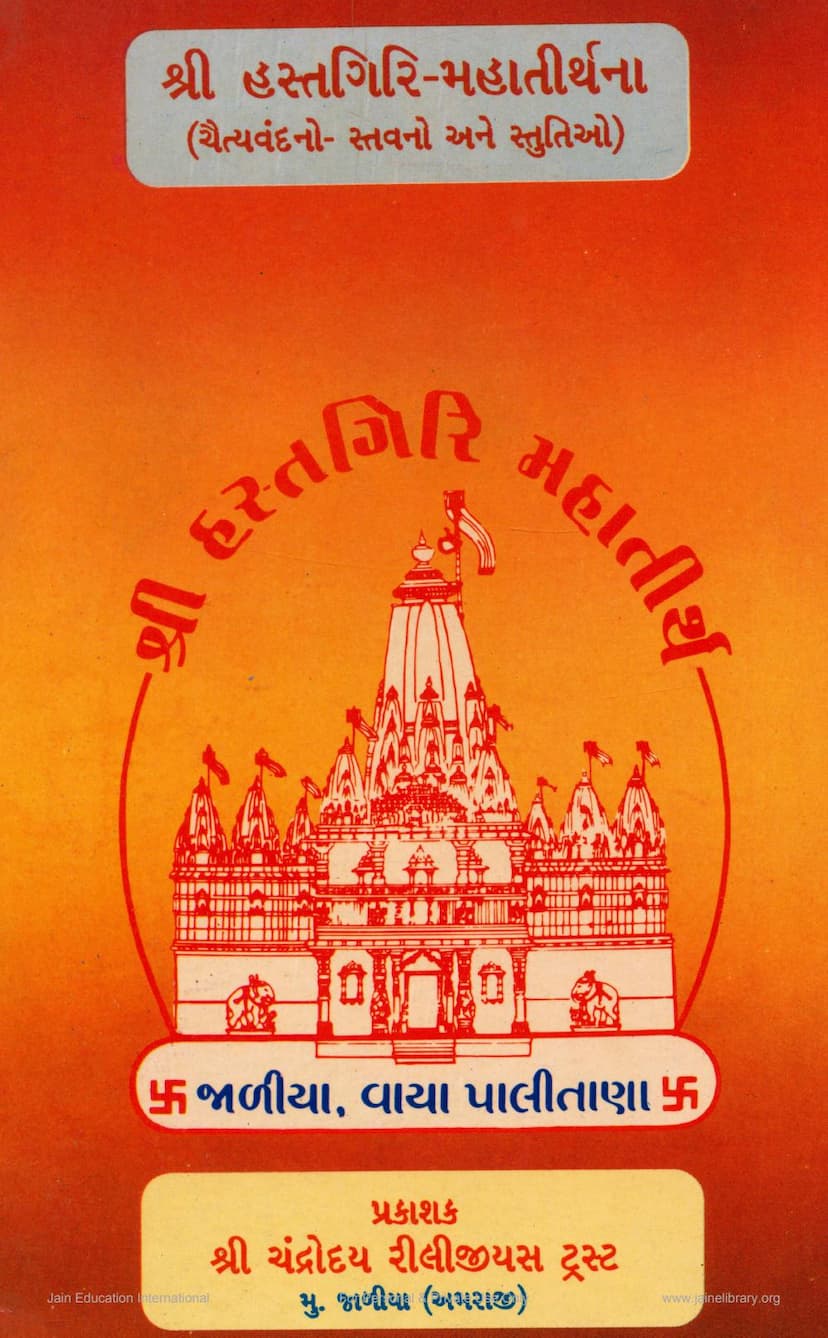Hastgiri Mahatirth Chaityavandano
Added to library: September 1, 2025

Summary
This document, titled "Hastgiri Mahatirth Chaityavandano" by Punyapalsuri and published by Shri Chandroday Religious Trust, is a Jain religious text containing prayers, hymns, and praises related to the Hastgiri Mahatirth (a significant Jain pilgrimage site).
Here's a comprehensive summary of its content:
1. Introduction and Location:
- The book is dedicated to Shri Hastgiri Mandan Shri Adinathaya Namah.
- It is presented as a collection of Chaityavandans (rituals of reverence), Stavans (hymns), and Stutis (praises) for the five Kalyanak (auspicious events) Jin Temples of Hastgiri Mahatirth.
- The location is specified as Jaliya, via Palitana, Gujarat, India.
- The preface highlights the serene and beautiful natural surroundings of Jaliya, with the Shatrunjay River flowing nearby. It describes how the sight of Shatrunjay, Kandabgiri, and Hadavala hills from Jaliya evokes a feeling of family, with Hastgiri being like a son and other hills like grandchildren.
- Hastgiri Mahatirth is situated 16 km from Palitana. The journey to the foothills of Hastgiri is described as increasingly captivating.
- The foothills themselves are depicted as a beautiful small town with facilities like a Bhojanshala (dining hall), Dharmashala (guesthouse), magnificent Jin temples, and an Upashraya (monastery).
2. Inspiration and Development of Hastgiri Mahatirth:
- The primary inspiration for the construction of Hastgiri Mahatirth comes from the teachings and blessings of the highly influential Jain monk, late H.H. Shrimad Vijayramchandrasurishwarji Maharaj, and the encouraging vision of his scholarly disciple, late H.H. Shrimad Vijaymantungsurishwarji Maharaj.
- The text mentions that a decade prior, only a small dilapidated shrine existed at the site, but now it has become a renowned and grand pilgrimage center.
- The main pilgrimage site features five temples, each dedicated to one of the five Kalyanaks of Bhagwan Adinath (the first Jain Tirthankar):
- Shri Chyavan Kalyanaka Mandir: Located at the foothills, resembling a divine chariot.
- Janma Kalyanaka Mandir: Situated in the middle of the hill on the path upwards.
- Diksha Kalyanaka Mandir: Located in the central part of the hill further up the path.
- Kevalgyan Kalyanaka Mandir: Currently nearing completion at the highest point, described as a colossal, grand, and beautiful Jin temple.
- Nirvana Kalyanaka Mandir: This is the ancient and original site of Hastgiri, marked by the footprints of Lord Rishabhdev.
3. Spiritual Significance and Purpose:
- Hastgiri Mahatirth is stated to have the same antiquity and influence as Shri Shatrunjay Mahatirth and offers equally rewarding spiritual benefits.
- Devotees are encouraged to perform Yatra (pilgrimage), Aradhana (worship), and Sadhana (spiritual practice) at Hastgiri with the same devotion as at Shri Siddhagiri Mahatirth, and to be mindful of not causing any disrespect (ashatana) to the holy place.
- The creation of these Chaityavandans, Stavans, and Stutis by H.H. Shrimad Vijaypunyapal Gurudev (a disciple of H.H. Shri Vijayviprodsurishwarji Maharaj) was a request to help pilgrims perform the rituals correctly, with the aim of shedding accumulated karma and achieving spiritual enlightenment.
- The ultimate wish is for pilgrims to use this book to perform the five Chaityavandans and attain immense karmic release, transforming their souls into the divine form.
4. Content of the Prayers and Hymns: The book then presents the Chaityavandans, Stavans, and Stutis for each of the five Kalyanaks, and also for the Rayan tree and Pundrik Swami, and Lord Parshvanath. Each section typically includes:
- Chaityavandan: A prayer recited during the ritual.
- Stavan: A devotional hymn, often set to a specific meter or melody.
- Stuti: A praise or encomium.
These sections detail various aspects of Lord Rishabhdev's life, his incarnations, the significance of the specific Kalyanak, and the architectural grandeur of the respective temples. They often invoke the blessings of the gurus who inspired the work.
Specific content within the prayers:
- Chyavan Kalyanaka: Describes the descent of Lord Rishabhdev into his mother Marudevi's womb, the auspicious dreams, and the lineage.
- Janma Kalyanaka: Details the birth of Lord Rishabhdev, his divine attributes, the celestial celebrations, and his parents.
- Diksha Kalyanaka: Recounts Lord Rishabhdev's renunciation, his giving of alms, his asceticism, and his attainment of liberation.
- Kevalgyan Kalyanaka: Focuses on the attainment of omniscience, the grand temple constructed (described in detail with its dimensions, number of pillars, and architectural features), and the legends associated with the site.
- Nirvana Kalyanaka: Celebrates the final liberation of Lord Rishabhdev, the footprints at Hastgiri, his renunciation at Ashtapada, and the establishment of the four-fold Jain community (Sangh).
- Rayan Tree and Footprints: Highlights the sacred Rayan tree under which Lord Rishabhdev delivered his sermons and the significance of his footprints.
- Pundrik Swami: Honors Pundrik Swami, the first Ganadhar (chief disciple) of Lord Rishabhdev, and his role in naming Pundrikgiri.
- Lord Parshvanath: Includes praises for Lord Parshvanath, detailing his past lives and his attributes.
- Shri Hastgiri Mandan Shri Adijin Stuti: General praise for Lord Adinath at Hastgiri.
- Gunathanani Stuti: A hymn dedicated to the twelve stages of spiritual progress (Gunathans).
5. Historical Timeline (Salvar Suvarna Gatha):
- The book concludes with a year-wise account of the development and construction activities at Hastgiri Mahatirth, starting from V.S. 2026 (1969 CE).
- This section details significant events like the initial resolve for renovation, land acquisition, architectural plans, foundation stone laying, consecration ceremonies of various temples, construction of facilities like the Bhojanshala and Dharmashala, and the installation of idols.
- It highlights the pivotal role of the gurus, particularly H.H. Shrimad Vijayramchandrasurishwarji Maharaj and H.H. Shrimad Vijaymantungsurishwarji Maharaj, in guiding these efforts.
In essence, "Hastgiri Mahatirth Chaityavandano" is a devotional guide for pilgrims visiting Hastgiri, offering them the prescribed prayers and hymns to enhance their spiritual experience and merit. It also serves as a historical record of the site's development, underscoring the dedicated efforts of the Jain monastic leadership and the devotion of the laity.